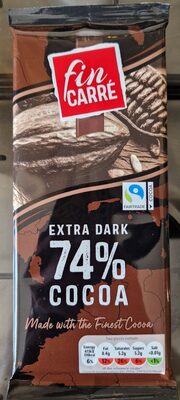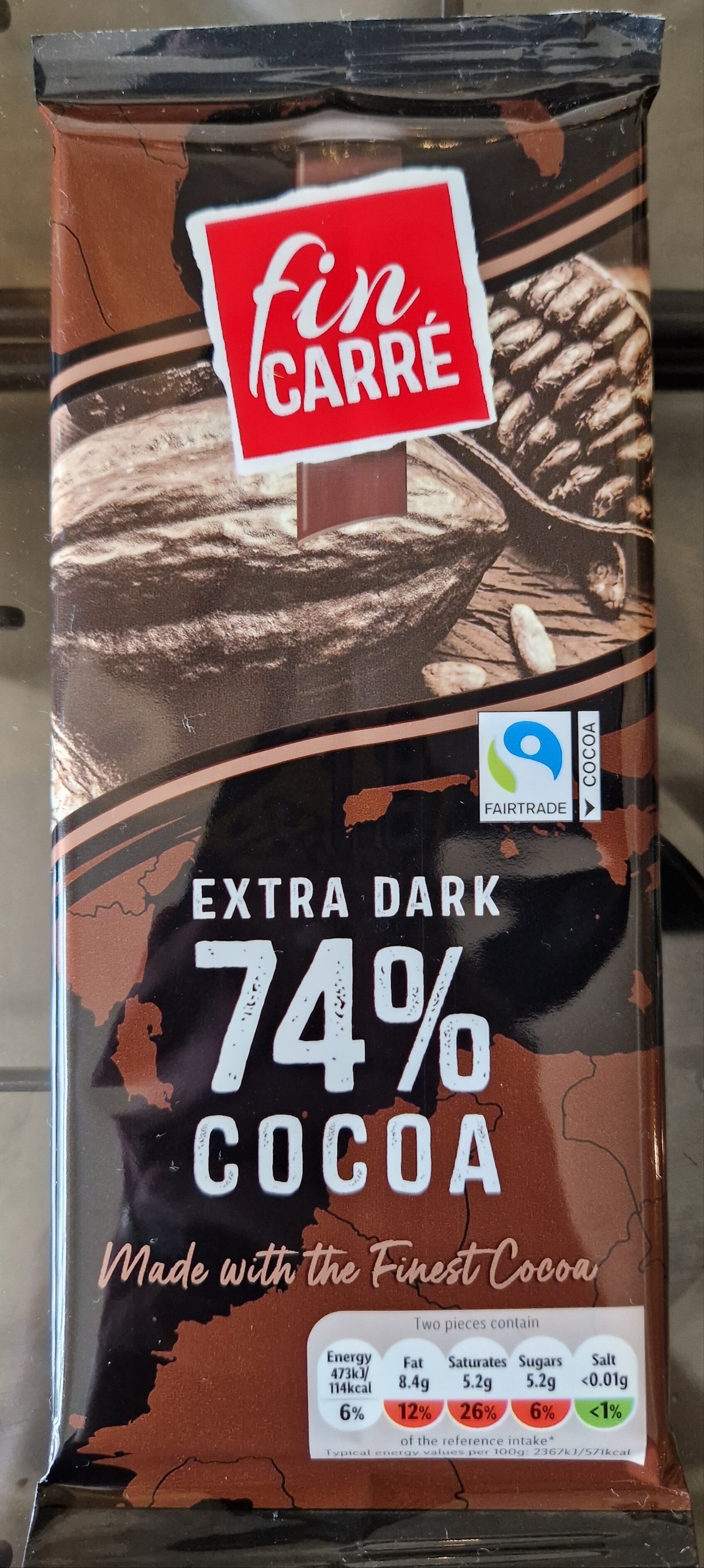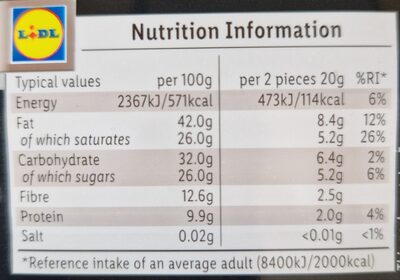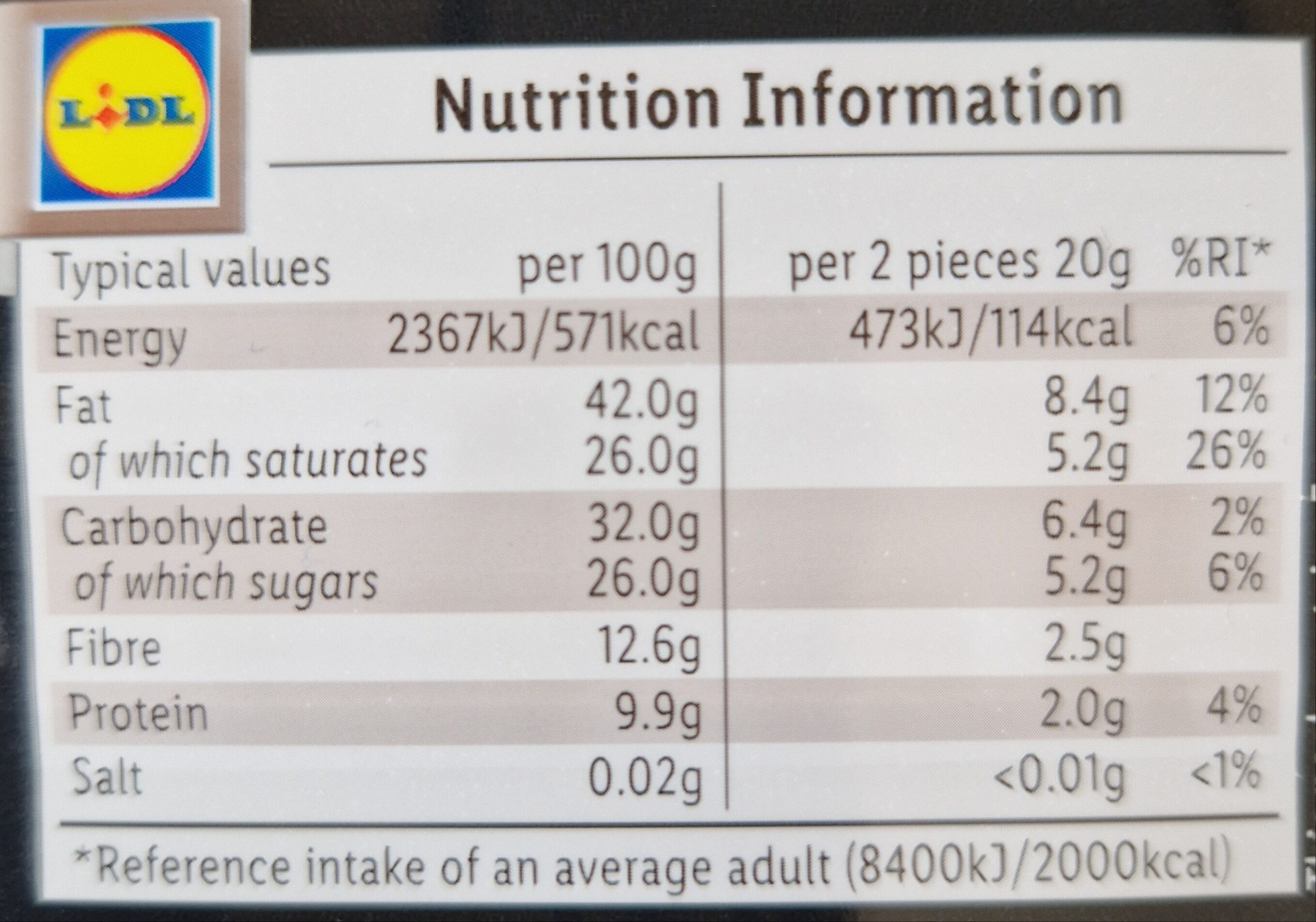Extra dark chocolate 74% cacao - Fin Carré - 100 g ℮
Ambiguous barcode: This product has a Restricted Circulation Number barcode for products within a company. This means that different producers and stores can use the same barcode for different products.
×
This product page is not complete. You can help to complete it by editing it and adding more data from the photos we have, or by taking more photos using the app for Android or iPhone/iPad. Thank you!
×
Barcode: 20022464
Quantity: 100 g ℮
Packaging: Mixed plastic-packet, Plastikowe, Sachet plastique de 3g
Brands: Fin Carré
Categories: Snacks, Sweet snacks, Cocoa and its products, Chocolates, Dark chocolates, Cacao-et-derives, Chocolats, Chocolats-noirs, Chocolats-noirs-extra-fin
Labels, certifications, awards:
Fair trade, Vegetarian, Fairtrade International, Vegan, Pure cocoa butter, Rainforest Alliance, Commerce-equitable, Pur-beurre-de-cacao

Manufacturing or processing places: Übach-Palenberg, Heinsberg (Kreis), Köln (Regierungsbezirk), Nordrhein-Westfalen, Deutschland
Traceability code: SOLENT GMBH & CO. KG, SCHWARZ BETEILIGUNGS GMBH
Stores: Lidl
Countries where sold: Belgium, Bulgaria, Czech Republic, Finland, Germany, Netherlands, Poland, Spain
Matching with your preferences
Environment
Carbon footprint
Packaging
Transportation
Labels
Report a problem
Data sources
Product added on by openfoodfacts-contributors
Last edit of product page on by risajanda.
Product page also edited by aleene, anticultist, arc2, autorotate-bot, bonobo77, date-limite-app, ecoscore-impact-estimator, edzeronk, emilbmwbg, fcousa, feat, finess2429, halal-app-chakib, inf, insectproductadd, javichu, jumati, k13b3r, kiliweb, kristina2003, moon-rabbit, musarana, neptuno, nicobur, nouky20, paperwings, pietrofratantonio, planteuser, quechoisir, rochus, roto, scanbot, sebleouf, smoothie-app, stephane, swipe-studio, tacite, tagah, teolemon, thaialagata, variaatio, yuka.U0xBK0M0a3QvOXdRdFBNYStEWFkrYzVaNEs2eWZFTzVKZE1OSWc9PQ, yuka.U2FreUd2VTluZDhzeThJYnhnTFQwUEZsOVpxUVYwT3VFZVk4SVE9PQ, yuka.UUpBSEw0NE9nZDVTdE1OZ3cwenIzTUFxNUlDT1h6dTFkTUZPSVE9PQ, yuka.UkpBc0s2OHhtK1ltcGZGZzBSbjU5dWhsNWNLQ2VsR1JJT2xOSVE9PQ, yuka.V2Z0YVQvVSt2dDBRd2M4eDRpUFFwT3BiNjgvNVh6dThPczVLSVE9PQ, yuka.WFowQk9mc2pwOUJXbnMwZ3hUN2MvT3BjeWFDclJqMjVjTnNoSVE9PQ, yuka.WVlJbUFZUTZtZE1UeThJT3B6M1R3YzVJNThDS0JucnVHN3NBSVE9PQ, yuka.Yi9rWUZwMFR0dWdHdC9BVjNDUDUzb2h2NU1hNVJFT1RkY01hSVE9PQ, yuka.ZHZrWks0Z25oc1lFbWNNNTAwanEzdjlTeUxLMEF6N21KTFFWSWc9PQ, yuka.ZWJnNElwb0h2TmxSa2ZNbTR6Q1A1K0p3L0xqMFpHNnFKcnNUSWc9PQ, yuka.ZmJJT0dhQS8rZUVYd3NFQS9CN295dGhvd1lLalhHeStPKzVOSUE9PQ, yukafix.
Last check of product page on by aleene.












